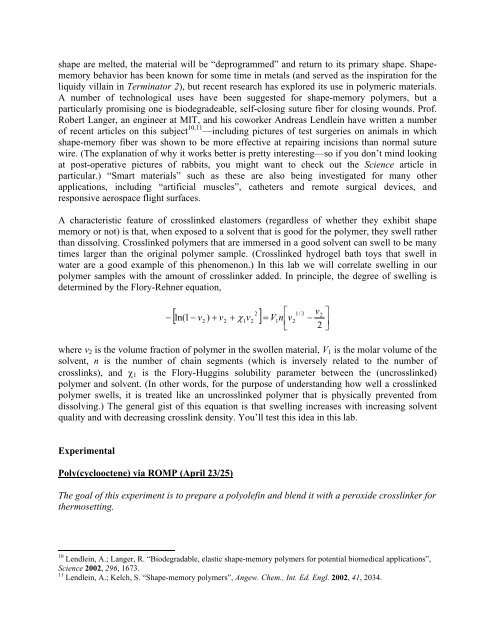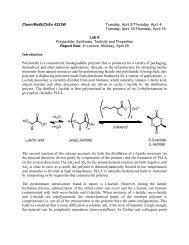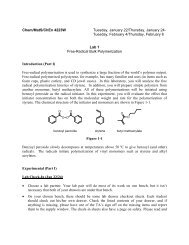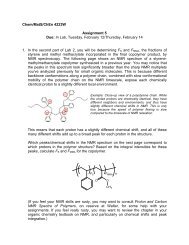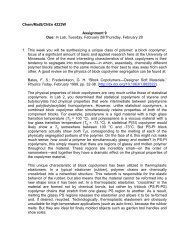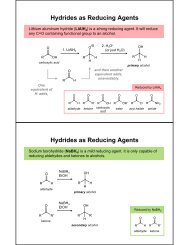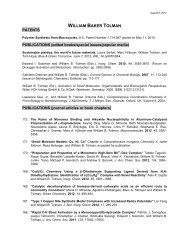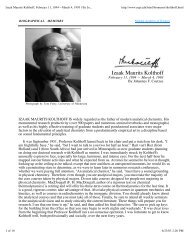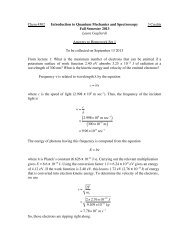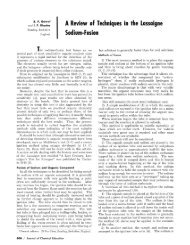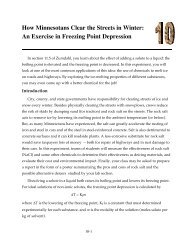Chem/MatS/ChEn 4223W Tuesday, April 23/Thursday, April 25 ...
Chem/MatS/ChEn 4223W Tuesday, April 23/Thursday, April 25 ...
Chem/MatS/ChEn 4223W Tuesday, April 23/Thursday, April 25 ...
You also want an ePaper? Increase the reach of your titles
YUMPU automatically turns print PDFs into web optimized ePapers that Google loves.
shape are melted, the material will be “deprogrammed” and return to its primary shape. Shapememorybehavior has been known for some time in metals (and served as the inspiration for theliquidy villain in Terminator 2), but recent research has explored its use in polymeric materials.A number of technological uses have been suggested for shape-memory polymers, but aparticularly promising one is biodegradeable, self-closing suture fiber for closing wounds. Prof.Robert Langer, an engineer at MIT, and his coworker Andreas Lendlein have written a numberof recent articles on this subject 10,11 —including pictures of test surgeries on animals in whichshape-memory fiber was shown to be more effective at repairing incisions than normal suturewire. (The explanation of why it works better is pretty interesting—so if you don’t mind lookingat post-operative pictures of rabbits, you might want to check out the Science article inparticular.) “Smart materials” such as these are also being investigated for many otherapplications, including “artificial muscles”, catheters and remote surgical devices, andresponsive aerospace flight surfaces.A characteristic feature of crosslinked elastomers (regardless of whether they exhibit shapememory or not) is that, when exposed to a solvent that is good for the polymer, they swell ratherthan dissolving. Crosslinked polymers that are immersed in a good solvent can swell to be manytimes larger than the original polymer sample. (Crosslinked hydrogel bath toys that swell inwater are a good example of this phenomenon.) In this lab we will correlate swelling in ourpolymer samples with the amount of crosslinker added. In principle, the degree of swelling isdetermined by the Flory-Rehner equation,2 ln(1 ) 1/ 3 v2v v v V n v 221where v 2 is the volume fraction of polymer in the swollen material, V 1 is the molar volume of thesolvent, n is the number of chain segments (which is inversely related to the number ofcrosslinks), and 1 is the Flory-Huggins solubility parameter between the (uncrosslinked)polymer and solvent. (In other words, for the purpose of understanding how well a crosslinkedpolymer swells, it is treated like an uncrosslinked polymer that is physically prevented fromdissolving.) The general gist of this equation is that swelling increases with increasing solventquality and with decreasing crosslink density. You’ll test this idea in this lab.2122ExperimentalPoly(cyclooctene) via ROMP (<strong>April</strong> <strong>23</strong>/<strong>25</strong>)The goal of this experiment is to prepare a polyolefin and blend it with a peroxide crosslinker forthermosetting.10 Lendlein, A.; Langer, R. “Biodegradable, elastic shape-memory polymers for potential biomedical applications”,Science 2002, 296, 1673.11 Lendlein, A.; Kelch, S. “Shape-memory polymers”, Angew. <strong>Chem</strong>., Int. Ed. Engl. 2002, 41, 2034.


